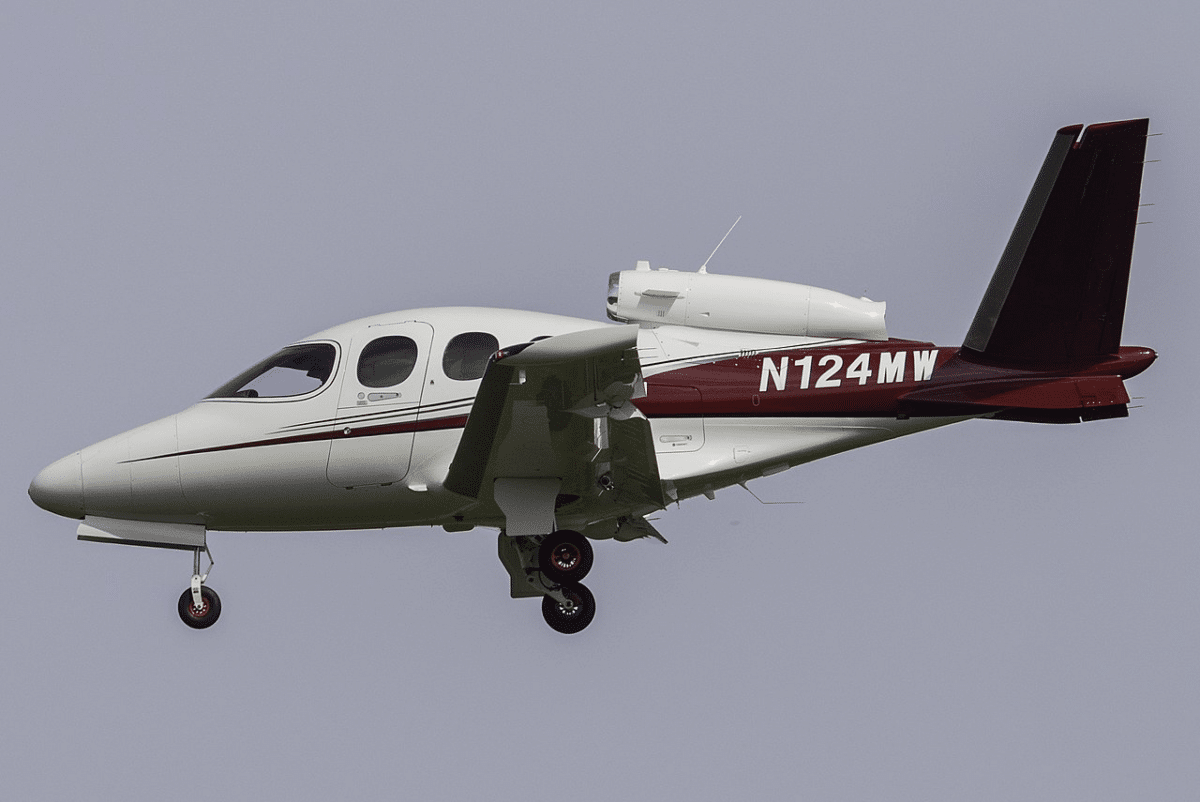Dive into the realm of private flying with the Cirrus Vision Jet, a trailblazing light jet that’s transforming the way we think about air travel.
Known for its blend of comfort, performance, and safety, this aircraft makes the luxury of private jet travel more attainable than ever before.
Table of Contents
How Much Does a Cirrus Vision Jet Cost?
As of 2024, the purchase price for a new Cirrus Vision Jet starts at roughly $2.85 million, with pre-owned models available from around $2 million, positioning it as a notably cost-effective option for entering the world of private jets. The annual operational costs stand at an estimated $180,000, covering insurance, hangar fees, maintenance, and management, while variable costs amount to about $670 per flight hour, inclusive of fuel and maintenance.
Key Points
- Costs: Purchase price starts around $2.85 million; Pre-owned models average $2.5 million
- Performance: 358 mph max speed; 1,200 nm range; 25,000 ft max altitude
- Capacity: Up to 7 passengers
- Efficiency: 50 gph fuel burn
- Safety: CAPS parachute system; Safe Return automated landing
- Luxury: Spacious, comfortable cabin; generous windows; premium materials

An Introduction to Cirrus Aircraft
Cirrus Aircraft, based in Minnesota, is known for manufacturing innovative single-engine piston aircraft.
In 2016, it introduced the Cirrus Vision Jet (SF50) – the world’s first FAA-certified single-engine personal jet. Designed to be pilot and passenger friendly, the Vision Jet ushered in a new era of safe, affordable, and modern private aviation.
The Vision Jet Redefines Private Flight
As the world’s first single-engine personal jet, the Cirrus Vision Jet (SF50) delivers impressive performance without the exorbitant price tag of larger aircraft.
Developed by Cirrus Aircraft as a “disrupter in aviation,” this very light jet provides more people access to the perks of private travel through its innovative design and reasonable operating costs.
An Aircraft of Many Firsts
The Cirrus Vision Jet holds the distinction as the first-ever type certified single-engine personal jet. But its trailblazing status goes beyond this feat.
It’s also the first aircraft with a whole airframe parachute system – the unique Cirrus Airframe Parachute System (CAPS) engineered to bring the entire aircraft down gently in an emergency. Plus, the Vision Jet introduced Safe Return, the first emergency autoland system designed for smaller aircraft.
This spirit of innovation empowers pilots with enhanced safety and accessibility. And passengers benefit from the simplified design and spacious, comfortable cabin accommodating up to seven adults.
Unparalleled Safety
Safety is a top priority for Cirrus Aircraft and the Vision Jet features multiple pioneering safety systems.
The CAPS parachute provides an extra layer of protection in the event of an emergency or crisis. If deployed, it brings the entire aircraft down slowly under the canopy for a safe landing.
The automatic Safe Return system is another impressive innovation. If the pilot becomes incapacitated, Safe Return analyzes conditions and terrain to guide the aircraft to the optimal airport for an automated landing. This technology provides reassurance to pilots and passengers alike.

Impressive Performance Stats
Despite its single engine, the Vision Jet delivers speed and range comparable to twin-engine jets. The Williams FJ33-5A turbofan engine and carbon fiber fuselage make it nimble and efficient. It has a maximum operating speed of 345 knots true airspeed and a range of up to 1,200 nautical miles.
The Vision Jet is powered to cruise at higher altitudes up to 25,000 feet, providing smoother rides above turbulence. With a maximum payload of 1,100 pounds, it offers ample capacity for passengers and fuel. The cabin is pressurized for comfort at cruising altitudes.
Luxurious Cabin Built for Comfort
The Vision Jet features a spacious cabin with comfortable seats and large windows for natural light. The interior height of 6’2” allows passengers to walk comfortably through the aisle. Seats are ergonomically designed and can be reclined for resting.
For entertainment, passengers have USB charging ports at each seat. Cabin lighting creates a bright and inviting ambiance. Climate is controlled via dual zone environmental systems. Up to 7 adults can be accommodated in the standard configuration.
The baggage area offers plenty of room for luggage and equipment. The cabin can also be customized with optional equipment packages catered to the owner’s needs.
Efficient Engines Maximize Performance
The Vision Jet is powered by a Williams International FJ33-5A turbofan engine delivering 1,846 lbs of thrust. The carbon fiber composite airframe ensures maximum durability while keeping weight low. This contributes to the aircraft’s excellent thrust-to-weight ratio and fuel efficiency.
The Vision Jet’s avionics suite features three large flight displays provided by Garmin G3000. Key benefits include visual flight rules navigation, terrain awareness warning systems, weather radar, and satellite datalink for real-time weather updates.
Additional specifications include:
- Max Takeoff Weight: 6,000 lbs
- Max Altitude: 25,000 feet
- Max Payload: 1,100 lbs
- Max Fuel Capacity: 1,400 lbs
Efficiency Meets Luxury
A key advantage of the Vision Jet is its fuel efficiency. The Williams International FJ33 turbofan engine allows a max cruise speed of 358 mph while burning just 50 gallons per hour. This gives it lower operating costs than larger twin-engine jets.
Despite its smaller size, the Vision Jet doesn’t compromise luxury. The thoughtfully designed interior features reclining seats, ample legroom, large windows, and premium materials. With its generous 6’2″ cabin height and customizable configuration, the Vision Jet balances utility and comfort.
Ownership Cost Breakdown
One major appeal of the Vision Jet is its lower acquisition and operating costs compared to larger private jets. Here’s a closer look at the key costs owners can expect:
Purchase Price
- New: $2.85 million
- Pre-owned: Avg $2.5 million
Annual Fixed Costs
- Insurance: $35,000
- Hangar Rental: $30,000
- Maintenance: $40,000
- Management Fees: $40,000
- Total: ~$180,000
Hourly Variable Costs
- Fuel: $350/hour
- Maintenance: $320/hour
- Total: ~$670/hour
While exact costs vary, the Vision Jet offers significantly more affordable ownership compared to larger $5 million-plus turbofan jets.
Ownership Opportunities
As a smaller jet, the Vision Jet allows more aircraft owners to experience the perks of private aviation. Purchase prices start around $2 million for pre-owned models, making it one of the most accessible jets available. With experience requirements less stringent than larger jets, more pilots can qualify to fly it.
Operating costs are another major factor for owners. With estimated annual fixed costs of $179,657 and low maintenance needs, the Vision Jet offers a relatively manageable budget compared to pricier twin-engine options.
For individuals and businesses seeking to enter the private jet market, the Vision Jet delivers an optimal balance of affordability and luxury.
Delivery and Ownership Experience
After ordering a new Vision Jet, owners can expect a professional delivery process coordinated by Cirrus. Aircraft undergo extensive inspection and flight testing at the factory prior to handover.
Many buyers opt to participate in a structured training program for Type Rating certification. This involves ground school, simulator lessons, and Cirrus factory training flights. Obtaining insurance also requires demonstrating proficiency.
Within the Cirrus community, Vision Jet owners have access to support networks for advice and shared best practices.
Owners praise the aircraft’s smooth handling, safety systems, and passenger experience. While not the fastest jet, it wins favor as a stable, efficient and comfortable aircraft perfect for personal and business needs.
Final Thoughts
The pioneering Cirrus Vision Jet gives more flyers access to the world of private aviation. With its innovative design, passenger comforts, and cost-conscious engineering, this very light jet redefines modern air travel.
For pilots and passengers alike, the Vision Jet offers an unforgettable flying experience full of luxury, safety and adventure.
I personally love it, but sadly, I’m not sure I can afford one – yet!